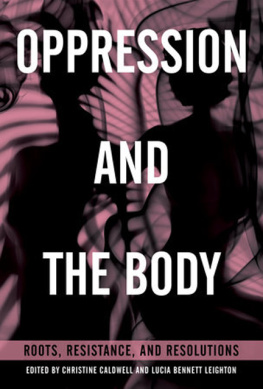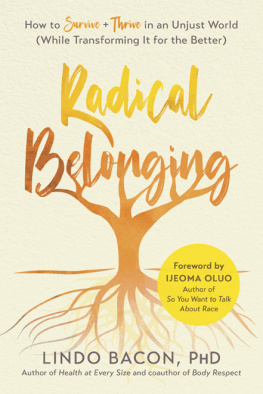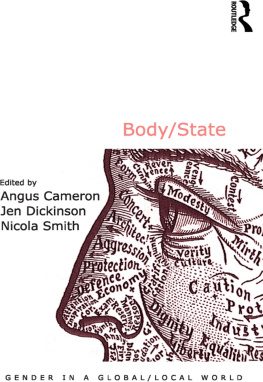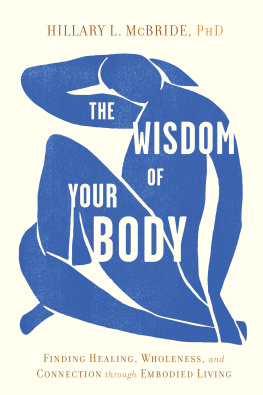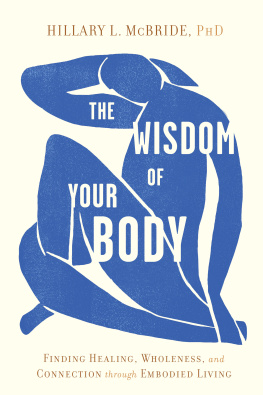
Copyright 2018 by Christine Caldwell and Lucia Bennett Leighton. All rights reserved. No portion of this book, except for brief review, may be reproduced, stored in a retrieval system, or transmitted in any form or by any meanselectronic, mechanical, photocopying, recording, or otherwisewithout the written permission of the publisher. For information contact North Atlantic Books.
Published by
North Atlantic Books
Berkeley, California
Cover design by Bill Zindel
Interior design by Happenstance Type-O-Rama
Cover images shutterstock.com/Slavko Sereda, shutterstock.com/Gargantiopa, and shutterstock.com/DK samco
Oppression and the Body: Roots, Resistance, and Resolutions is sponsored and published by the Society for the Study of Native Arts and Sciences (dba North Atlantic Books), an educational nonprofit based in Berkeley, California, that collaborates with partners to develop cross-cultural perspectives, nurture holistic views of art, science, the humanities, and healing, and seed personal and global transformation by publishing work on the relationship of body, spirit, and nature.
North Atlantic Books publications are available through most bookstores. For further information, visit our website at www.northatlanticbooks.com or call 800-733-3000.
Library of Congress Cataloging-in-Publication Data
Names: Caldwell, Christine, 1952- editor. | Leighton, Lucia Bennett, editor.
Title: Oppression and the body : roots, resistance, and resolutions / edited
by Christine Caldwell and Lucia Bennett Leighton.
Description: Berkeley, California : North Atlantic Books, [2018] | Identifiers: LCCN 2017043736 (print) | LCCN 2017051944 (ebook) | ISBN 9781623172022 (ebook) | ISBN 9781623172015 (pbk.)
Subjects: LCSH: Human bodySocial aspects. | Human bodyPolitical aspects.
| Discrimination.
Classification: LCC HM636 (ebook) | LCC HM636 .O67 2018 (print) | DDC
305dc23
LC record available at https://lccn.loc.gov/2017043736
North Atlantic Books is committed to the protection of our environment. We partner with FSC-certified printers using soy-based inks and print on recycled paper whenever possible.
To all those whose bodies have been made wrong and To all those who have moved in the face of it
List of Figures
- Las Tristes, Muertas y Dormidas by Polina Porras Sivolobova
- Untitled (Its Your World) by Andria Morales and Damien Davis
- Embodied Code-Switching Feedback Loop
- Identity Expression Infinity Loop
- Personal Example of Code-Switching Feedback Loop and Identity Expression Infinity Loop
- The Moving Cycle
- Differences among Body Dysphoria, Social Dysphoria, and Oppressive Social Norms
- TD Group Therapy Model
List of Tables
- Table 7-1Participant Demographics
- Table 12-1Moving Cycle Tools and Oppression-Focused Interventions
Preface
Who We Are and Why Were Here
Lucia
I am white and cisgender and gay. I am a first-generation American but only on one side of my family. I grew up poor. Because of my whiteness, I received the message that all spaces were for me and that I belonged in them. I can move through most spaces in my world with relative ease, without having to change myself or the way my body looks or acts, and no one questions why I am therewhether in a restaurant, a graduate school, or any particular neighborhood. My whiteness has protected me from much of the oppression discussed in these chapters, and I will therefore never fully know the depth of what many of the authors describe.
In retrospect, it should have been pretty obvious to everyone that I was gay from a very young agefor example, I wrote a detailed love letter to my German babysitter, complete with red stationary. Despite my liberal and accepting parents, however, when it finally dawned on me at age thirteen that I was different, I was filled with shame. Id spent my life until then trying to be the same as everyone else, rehearsing and performing the part of the perfect, nice white girl while hiding my parents poorness and my upbringing in a strange, hippie community that served adults with developmental disabilities. I turned the shame I felt inward and blamed my body. My body became a fleshy, hateful animal, an object so intimately associated with all my faults and yet also so inexplicably not mine. My body was a battleground. I knew there was something wrong with it, something shameful and dirty, and I was going to punish it and control it. I was going to forcefully mold it into something that wasnt shameful and that would actually deserve love. I thought that maybe if I turned into one of the TV women I so admired, I would love men; that maybe the reason I had no interest in them was that I wasnt female enough; and that maybe if I turned myself into Nicole Kidman, I would also feel gentle and feminine and docile. Subsequently, then, possessing these characteristics would somehow elicit proper feminine desires and behaviors.
Im still really gay, but now Ive figured out how to not store all that shame and blame in my body but, rather, to leave it where it rightfully belongswith the people and society that tried to shame and blame me in the first place. In so doing, I am able to reclaim my body for myself. Thats why this book is so important; in it, so many of our authors are naming how oppression has affected their bodies or the bodies of folks close to them. Theyre acknowledging the impact societies have on our bodies, our identities, and our self-concepts; deconstructing the insidious effects of discrimination; and discussing how to reclaim a relationship to our body.
Christine
During most of my life, I have enjoyed a tremendous amount of body privilege. I was born able-bodied, white, cisgendered, lower middle class, and not too big, not too little. Without realizing it at the time, these descriptors afforded me tremendous advantages. I moved through my childhood feeling relatively safe, relatively normal, and quite oblivious to the idea that it could be any other way. My first conscious thoughts concerning my body status occurred during my teen years when I began to experience doubts about my looks (I understood my face to be homely), and I began to realize that as a girl I could be preyed upon, necessitating a physical conservatism involving how I dressed, where I went, and how I moved and gestured.
In college, I had an African American boyfriend, and my pale skin and straight hair were regularly teased by his black friends, sometimes in fun, sometimes not. I always felt physically safe with him, but I directly witnessed his lack of physical safety in most public spaces, both as a young black male and as a young black male with a white woman on his arm.
Like every woman I know, I have been sexually harassed and exploited by men of all ages and races my whole life. From my teen years onward, I have experienced my body as both political and personal, as both mine and not mine. This realization so moved me that I have devoted my life to the study of the body, as an academic, a researcher, a therapist, and a writer. I have also devoted myself to dancing, to giving and receiving massages, and to valuing my physicality as much as I can.
I am now sixty-five years old, still white, still well educated, still relatively able-bodied, and still middle class. These sociocultural locations still afford me tremendous privileges. I have also come to see that I am bisexual, that my decision to marry my husband was not about gender but about love, and that my youthful sexual experiments were not to be dismissed but included. I still struggle with my homely face. Now I add in my struggles with size because I weigh more than the norm says I should. It amazes me how much shame I feel about my size, given how long I have been at the business of examining internalized body biases. In public, I regularly experience a kind of somatic invisibility that older people report, a sense that we elders are not accounted for or physically appreciated.
Next page
